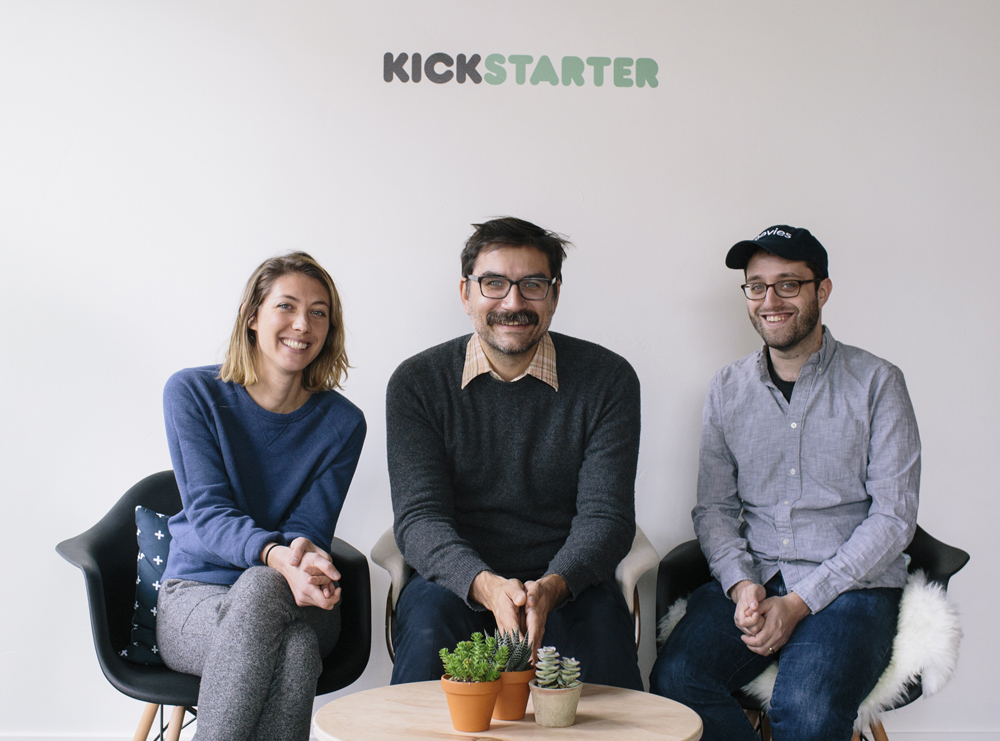This week, we’re profiling innovative companies that are making the world of film a better place.
It’s the morning after Kickstarter has announced a partnership with Kodak for a new program giving filmmakers access to free 35mm or 16mm film for their projects, and Jane Schoenbrun, Liz Cook and George Schmalz’s inboxes are full.
“It’s really incredible. We are getting e-mails from people all over the world,” marvels Cook, Kickstarter’s film outreach lead for documentaries.
“I did not expect it to explode as it has in the past 20 hours,” concurs Schmalz, the company’s film outreach lead for genre and restorations. “I’m excited to see where it goes.”
Watching where things go has long been one of the best perks of working at Kickstarter, located in an industrial neighborhood in Greenpoint, Brooklyn increasingly being repurposed for other means. But within the steel beams and exposed wood of its modern yet earthy headquarters, they still build things here, and in spite of the many incredible projects that have been financed as a result of Yancy Strickler, Perry Chen and Charles Adler’s grand experiment of crowdsourcing that started seven years ago, it’s likely the most impressive project Kickstarter has constructed is itself.
While they pioneered the ability to collect money far and wide for creative endeavors that wouldn’t be possible otherwise, what’s emerged as time has gone on is how Kickstarter has developed something not as easily spent — but possibly even more valuable — in the infrastructure inherent in each campaign that allows artists to keep in touch with their patrons long after the fundraising is over with. This less recognized aspect of Kickstarter was brought to the fore last spring when the company underwent a site redesign and introduced Spotlight, simplifying the design of the site to highlight a timeline tracking any given project’s life from conception to release, shifting the focus from the plea for donations to an ongoing conversation with donors.
“The raising of the money is really just a means to a larger goal of making something, so that Spotlight feature is all about creating a sustained home for that project over a long period of time where you can talk to your audience, and hopefully press and industry to really advocate for your film, have a home base for it and really just grow that together with people,” says Jane Schoenbrun, the company’s senior film outreach lead who works primarily on narrative projects.
“You can never do it without the money, but it is always about telling filmmakers about the other bonuses of coming to the site,” adds Schmalz. “You’re building a community, and oftentimes the first group of people who really care about what it is you’re creating, so [you can] start to really think about it in those terms versus the dollar sign part of it.”
For many filmmakers who know how to light a shot, but hold no illusions about how to market themselves or their film, this has become a godsend, just as Kickstarter’s film outreach program has become equally helpful in getting one’s project off on the right foot. Schoenbrun, Schmalz and Cook have become a familiar sight on the festival circuit, all directly engaging with the film community either on panels or talking to filmmakers who might already interested in running Kickstarter campaigns on whether it would make sense and how they could best position their work on the platform. Often, these conversations actually serve a creative function as much as a potential financial or promotional one, clarifying a sense of purpose.
“It’s really the same core questions that you, as a young filmmaker, have to ask yourself, which is, “Why am I making movies?” says Schoenbrun, who sees his current gig as an extension of his prior one at the non-profit Independent Filmmaker Project (IFP) where they were an associate director of programming. “The job of any film support organization is to not prescribe what a filmmaker should do, but to really help them better understand what they want out of making art, and then achieve it. When you think about what a Kickstarter process actually is, it’s not like making a video and offering rewards. That’s the format of it, but at its heart, what filmmakers are doing are advocating for themselves and establishing who they are, why they make movies, and finding people that are going to care about and hear about those movies… At Kickstarter, it’s part of this very tangible, very specific moment where they’re, usually for the first time, talking to an audience.”
That audience is usually more abstract than filmmakers think it is, which is why Schoenbrun, Cook and Schmalz have worked behind the scenes to help make connections that may not show up on a Kickstarter backers’ list during a campaign. While friends and family remain a foundation for most Kickstarter campaigns, the Kickstarter team has hired a full-time publicist for its film efforts and initiated a newsletter for influencers and financiers, managers, festival programmers, agents and other industryites to keep them in the loop about the most exciting films raising funds, using the platform’s unique ability to get in on any given project on the ground floor as a way to get professionals tracking it early.
Says Schoenbrun, “When I work with creators, [the question] isn’t just how much money do you need, it really is like, whose radar do you want to get on? What kind of press is going to help introduce this to audiences? What kind of industry attention do you want? Is this an opportunity to get it on festival programmer’s radar? Is this an opportunity to build buzz before a premiere? Is this an opportunity to establish enough data that you can take to streaming platforms and really show them that there is an audience for this film? That’s something that we see at all levels.”

Schoenbrun experienced the power of this connectivity first-hand in their own capacity as a filmmaker. For “collective:unconscious,” which recently made its world premiere at SXSW, he enlisted a group of filmmakers – Lily Baldwin (“Sleepover LA”), Frances Bodomo (“Boneshaker”), Daniel Patrick Carbone (“Hide Your Smiling Faces”), Josephine Decker (“Butter on the Latch”), and Lauren Wolkstein (“Social Butterfly”) – to interpret each other’s dreams in omnibus form. In a practical sense, this likely would never have happened without Kickstarter – all the filmmakers notably used Kickstarter to fund their own projects in the past and the idea of wrangling a group of veritable unknowns for an experiment might’ve been difficult to finance through traditional means. Yet after originally being envisioned as a web series, the confidence instilled by both the successful Kickstarter campaign and the subsequent shoot led to the idea of turning it into a feature, a sum is greater than its individual parts moment that would seem to epitomize what the site has been working towards since its inception.
As Kickstarter has grown, the relationships they’ve forged have transcended one-to-one relationships to now include partnerships with major organizations that can actually make the filmmaking process easier. Besides the new collaboration with Kodak, the company has joined with the Sundance Institute, which now has a dedicated team helping festival alums find a way forward for their projects with Kickstarter campaigns, a co-venture that’s generated over $12 million for over 100 projects since 2011. More recently, they struck a similar arrangement with the Berlinale Talents Program, the accompanying creative academy of the Berlinale Film Festival in February to help its 6,000-strong network of filmmakers achieve their goals.
Once a film has been made, Kickstarter has also leveraged the strength of their brand to help rise above the din when it’s released, whether it’s their day-long festival in the fall, which broadcasts a collection of shorts and features that have been funded through the site to theaters across North America, or its ongoing collaboration with The New York Times, which has hosted crowdsourced short-form documentaries on its Times Video platform since last fall.
“We’ve been doing a lot of thinking about how can we better be that facilitator of connecting filmmakers, not only to financing to make their films, but also to opportunities,” says Schoenbrun. “What that means is talking to the people who are backing projects, talking to the people that can help projects, and really having this be the place where creative projects are finding their people, whether those are just regular people at home who are going to love this movie or somebody who can help in a really substantial way.”
That’s why during my visit to Kickstarter, on the eve of a massive 7th anniversary party where the evening’s entertainment, Dan Deacon, would (fittingly) lead a crowd into the streets of Williamsburg, there was as much contemplation about the future as celebration of the past in the film division. After establishing itself as the predominant crowdsourcing service, still synonymous with the concept even as many other competitors enter the fray, Kickstarter enters an era where producers budget their next films based on how much they raised from a successful previous campaign and film festivals such as North Carolina’s Cucalorus Film Festival and New York’s Rooftop Films annually set up a campaign for a significant part of their operating budget.
Yet it’s obvious as much as filmmakers have embraced Kickstarter to do repeat business, the company’s film team is eager to keep refining the crowdsourcing process and accounting for all the different needs that filmmakers have, often inspired by the artists who — not surprisingly — come up with the most creative ways to crowdsource.

Meanwhile, Cook is excited for the potential for virtual reality projects, singling out the recent campaign for “Blackout,” which allows a viewer to envision the lives of everyone they see in front of them during a power outage on a NY subway and offered up downloads for the Oculus Rift as a reward. She has also been continually intrigued by the way in which documentary filmmakers have used Kickstarter to get films to the public that powerful interests might not want them to see.
“There are a handful of documentaries that I’ve worked closely with that are really sensitive in subject matter, and to run a very public Kickstarter campaign, they have to time it perfectly so it doesn’t influence the subject or put anybody in danger,” says Cook. “There was a film called ‘(T)error,’ [which had] an [errors and omissions] insurance that got quoted as something like four times higher than ‘Citizenfour.’ They were able to really galvanize the community around the idea that this is a fee that has to be paid in order for the public to actually see this type of information.”
Although Cook, Schoenbrun and Schmalz have barely had time to catch their breath in recent months as they’ve hopped from Berlin to SXSW to Cannes, they only need to look at the festival schedule wherever they’ve landed to see the fruits of their labor. At this year’s Sundance Film Festival, the company set up a space on Main Street with a big wall adorned by pictures of all the Kickstarter-funded movies both present and past, stopping many who were trudging past in the snow to stop and snap a selfie.
“It was so cool to see people who we hadn’t seen in two years would come in there, take a picture next to the film that was at Sundance two years ago on the wall, and be like, ‘Oh my God, Kickstarter remembers,'” recalls Schoenbrun with the deeply satsifed grin of a proud parent.
For the trio, it was an equally rare opportunity to stop and take in the moment before returning to the business of thinking about the future and moving forward.





Comments 2